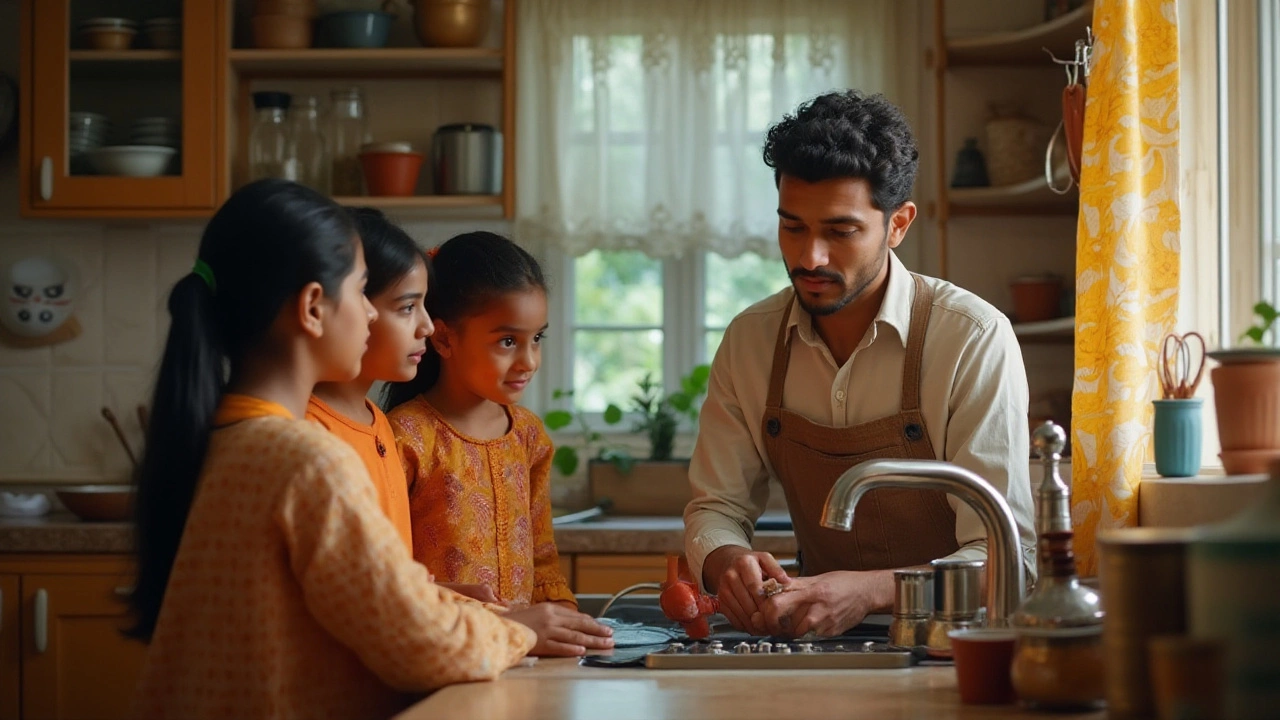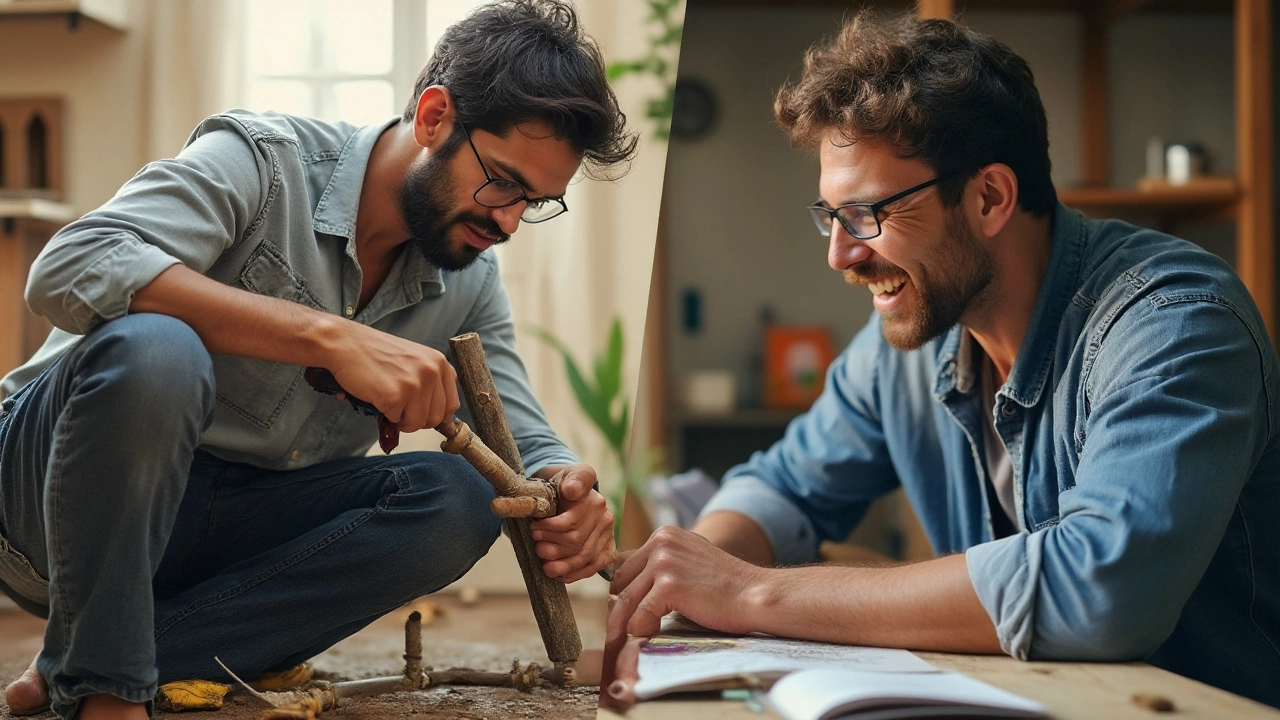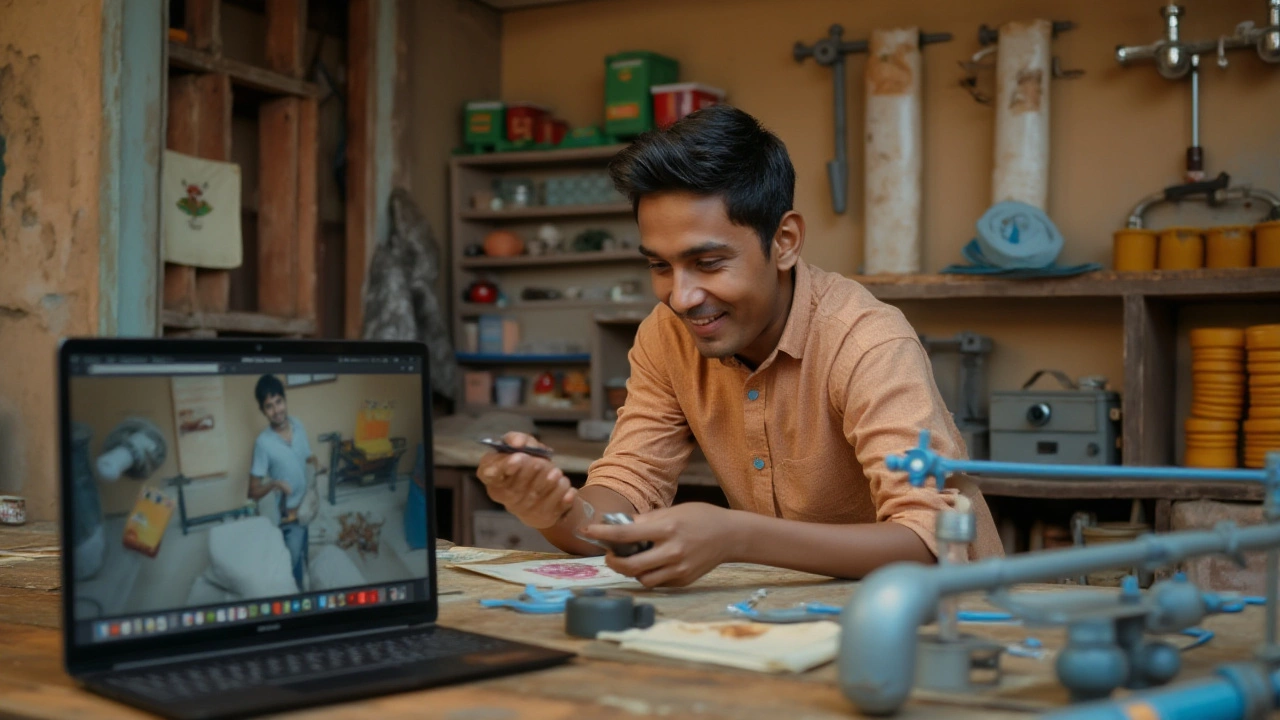Is it possible to learn plumbing without stepping into a classroom? In today's DIY culture, many enthusiastic learners are asking themselves this very question. As technology enables us to access a wider array of resources, the idea of teaching oneself important household skills, such as plumbing, is not only appealing but also feasible.
Before diving into your own pipes and drains, it's important to consider the foundational concepts and skills involved in plumbing. Understanding the science behind the flow of water, pressure, and the technology of various fixtures can be both exciting and complex. It's crucial to approach this with a mindset open to continual learning and practice.
Equipping yourself with the right tools is just as important as gaining theoretical knowledge. Tools, when chosen wisely, can make or break your plumbing projects. While plumbing tools can be quite the investment, starting with a few essentials might just set you on the right path to mastering the craft.
However, the journey isn't without its pitfalls. Aspiring plumbers might find themselves facing challenges that require a bit of troubleshooting and, quite often, humility. Learning from common mistakes and understanding when a professional's touch is needed can save one a lot of hassle.
Yet, despite the enticing prospects of self-learning, sophisticated plumbing systems sometimes demand professional training and certifications. Exploring the balance between self-taught skills and professional guidance can help you decide the best route forward on your plumbing adventure.
- Understanding Basic Plumbing Concepts
- Essential Tools for Self-Taught Plumbers
- Common Mistakes and How to Avoid Them
- The Benefits of Professional Training
- When to Call in a Professional
Understanding Basic Plumbing Concepts
Taking the plunge into the world of plumbing starts with grasping the very basics. At its core, plumbing is all about systems – systems that deal with the flow of water, removal of waste, and distribution of gases. To be a self-taught plumber, comprehending these systems not only builds your foundation but also ensures you can navigate issues effectively as they arise. Water supply, drainage, and venting systems are three pillars in plumbing that one needs to understand. Each of these plays a crucial role in ensuring our homes run smoothly, supplying us with clean water and removing waste efficiently.
The water supply system is all about how water enters our homes and how it is distributed to various outlets. This involves understanding pressure, piping, and valves. Water pressure must be balanced correctly; too high, and it could cause damage, too low, and it becomes ineffective. Moreover, knowing how different types of pipes function and their materials (like copper, PVC, or PEX) is vital in understanding their interactions and longevity. On the flip side of water supply, we have the drainage aspect, which terminates waste properly. A balanced combination of gravity and design ensures long, trouble-free service. The venting system, which is perhaps the least understood by novices, is just as crucial as any other, as it ensures that gases from sewer lines don't enter the living spaces.
Key Components of Plumbing Systems
In a typical household, plumbing comprises various components designed to work in harmony. Fixtures such as sinks, showers, and toilets are what most people interact with daily. Yet, it's the less visible parts that require attention when one is learning. Pipes and fittings come next, forming a network to transport water and air. Essential too are elements like water heaters and filtration systems, which add layers of functionality to the basic structure. Each component has unique attributes. For instance, the choice between a tankless water heater and a traditional tank-style one can impact energy usage and efficiency.
"Plumbing follows the basic laws of nature – gravity, pressure, and water seeking its own level." – Family Handyman
Learning to identify and understand these components comes with practice and study. Resources are abundant for budding self-taught plumbers. Online courses and tutorials, coupled with inspection of your own home’s system, offer great ways to visually grasp these elements. Getting up close and personal with the pipes, feeling the material, and noticing the layout can deepen your comprehension. If possible, consulting building codes offers another layer of understanding, ensuring that your self-taught journey aligns with legal standards, which are imperative for safety and proper functionality.
Tackling Common Challenges in Plumbing
Every budding plumber encounters challenges, but tackling them builds resilience and capability. Issues like leaks, clogs, and unanticipated pressures are common hurdles. Learning how to detect a leak can save heaps of trouble. This often begins with monitoring your water meter and understanding fluctuations in water usage. Recognizing signs of clogs and learning different unclogging methods, such as using a plunger, snake, or auger, is equally important. Understanding the reasons why these problems occur can lead you to preventive measures. This not only enhances your skills but also saves on future repairs.
By getting familiar with the typical signs and learning to use diagnostic tools effectively, you prepare yourself adequately for these challenges. Hands-on experience, perhaps with a mentor or through a training module, can augment self-learning. It's in these instances that aspiring plumbers build confidence, understanding that even the most complex issues have practical solutions. Emphasizing learning techniques such as these can inspire a sense of accomplishment, which is crucial for a self-taught skill set.
The journey to becoming proficient in plumbing might be long, but with patience and a quest for knowledge, the complexities unravel into manageable tasks. Keeping curiosity alive, consistently learning, and, most importantly, experimenting within safe bounds makes for a rewarding experience. As you dive deeper, these self-taught plumbing concepts become second nature, paving the way for both small repairs and major DIY projects. This solid foundation equips you to handle more advanced topics down the line, opening doors to mastering not only your home’s needs but potentially the needs of others.
Essential Tools for Self-Taught Plumbers
Embarking on your journey as a self-taught plumber means equipping yourself with the right tools to tackle common plumbing tasks with confidence. Understanding which tools are essential can make the process less overwhelming, especially when stepping into the unknown world of pipes, leaks, and repairs. Start by investing in a plumbing toolkit that has all the essentials. A good pipe wrench is an absolute must; it's the backbone of any plumber's toolbox. This tool is versatile enough to handle everything from tightening pipe connections to loosening fasteners. The adjustable nature means it can adapt to various sizes, providing a firm grip when needed.
Aside from the indispensable pipe wrench, a basic plunger is another humble yet mighty tool. It's your first line of defense against clogs. For most household plumbing issues, this simple tool is often sufficient to solve the problem quickly. Pair it with a plumber's snake, and you've got a dynamic duo capable of tackling those more stubborn blockages that may lie deeper within pipes. A measuring tape, while seemingly unrelated to plumbing, serves a significant purpose. Accurate measurements are crucial for installing new pipes or fixtures, avoiding costly errors that may arise from miscalculations. Additionally, a spirit level ensures that your installations remain even and properly aligned.
While numerous specific tools are available, knowing the purpose of each is key to making informed choices. Teflon tape, often overlooked, prevents leaks on threaded pipe joints. It's a plumber's secret weapon, providing a reliable seal on connections. A basin wrench is designed specifically to work in tight spaces, making it invaluable when dealing with sink faucets and fittings. For the committed DIY enthusiast, considering an investment in a blowtorch might be beneficial. Its ability to quickly solder connections makes it a valuable asset for more advanced projects.
Another piece of advice is to ensure your toolkit includes safety equipment like gloves and goggles. Protecting yourself while working is just as important as any tool in your kit. Consider this: Norman survives a horror ordeal because he wore gloves and goggles during a job. An anecdote shared by a seasoned plumber captures the essence of unexpected hazards in plumbing. Micheal, a practicing plumber for over two decades, famously stated, "A plumber without his safety gear is like a soldier without armor."
While it's understandable to want a well-rounded collection, take time to learn and understand how each tool works. This knowledge doesn't just build confidence; it also empowers you to make informed decisions on when to bring in professional help. With the right set of tools and a curious mind, the path to mastering plumbing can be both rewarding and enlightening.

Common Mistakes and How to Avoid Them
Learning plumbing through a self-taught approach presents its own unique set of challenges. Aspiring DIY plumbers often find themselves making mistakes that can range from mildly inconvenient to downright disastrous. One of the most common errors involves underestimating the importance of shutting off the water supply before commencing work. Failing to do this can result in water flooding into the area you’re working on, potentially causing damage to floors or other structures.
Another frequent mistake is using incompatible pipes and fittings, a blunder which novices make when they believe all materials are interchangeable. Different pipes have specific applications and choosing the wrong type can lead to leaks, often occurring weeks or months after the installation. It's crucial to pay attention to pipe materials; for instance, connecting galvanised steel to copper directly without a proper dielectric union is a recipe for corrosion. Seek guidance from resources or professionals if you're unsure what materials to use for your project.
Improper use of plumbing sealants like Teflon tape can also cause both amateur and seasoned DIY enthusiasts a great deal of trouble. Wrapping tape or applying liquid sealant requires precision; applying too little or too much affects the seal's integrity. A quote from plumbing expert Richard Trethewey perfectly sums up the issue:
"The tape should be wrapped three times around the threads for a proper seal. Any less is a leak waiting to happen, any more is a misfit."Take time to learn the correct technique to avoid this seemingly minor error that could lead to major leaks.
Inadequate venting is another significant issue that novice plumbers might overlook. Every plumbing fixture requires proper venting to ensure correct drainage and prevent sewer gases from seeping into the home. Without this, systems may clog frequently or, worse, pose health hazards. Newcomers might forget about these seemingly invisible components. Reading building codes or referring to plumbing diagrams can help immensely in understanding where and how vents are necessary.
Many DIY plumbers also tend to skip over safety measures. Not wearing the right safety equipment, such as gloves and goggles, can lead to injuries from snap-off fittings or exposure to harsh chemicals. Additionally, electrical grounding and circuit testing should be considered when dealing with systems that intertwine with electrical setups. Remember, plumbing sometimes involves heavy lifting, sharp tools, and confined spaces, so always take preventive actions seriously.
Lastly, one of the biggest misconceptions is assuming that any plumbing issue can be tackled by an enthusiastic amateur. Recognize when a problem is beyond your skill level; this could save you time, money, and possible injury. Ongoing leaks, major pipe replacements, or drainage issues should prompt you to call a seasoned professional. In the realm of plumbing, acknowledging when to seek help could make all the difference between a successful project and a catastrophic one.
The Benefits of Professional Training
Embarking on the journey of learning plumbing independently offers a sense of accomplishment and self-reliance. However, there comes a point when professional training can elevate one's skills in crucial ways. Professional training provides structured learning that helps aspiring plumbers understand complex systems and modern technologies effectively. This means acquiring not just theoretical knowledge but also practical, hands-on skills that are essential in the real world. Courses are often designed by industry experts who understand the nuances of the field, which ensures that students gain a comprehensive insight into plumbing.
One significant advantage of enrolling in a training program is the opportunity to learn from seasoned professionals. These experts are not only proficient in problem-solving and technical skills but also bring invaluable experience to the table. They can mentor students through practical modules, using real-life scenarios and equipment to bridge the gap between theory and application. This experiential learning is difficult to replicate through self-teaching, where trial and error might lead to frustration and possible damage to property.
Structured Learning Environment
In a classroom or workshop setting, students have access to specialized equipment and tools that may not be readily available at home. These environments are controlled and safe, allowing learners to practice and refine their techniques without the pressure of real-life consequences. Moreover, training courses often cover a wide range of topics, from basic repair techniques to advanced installation procedures, which prepare students for various situational challenges. The orderliness of structured learning ensures that no critical step is overlooked, something that might be missed during self-study.
Moreover, professional courses frequently offer certifications upon completion, which can be a significant asset when seeking employment or starting one's own business. These certifications serve as proof of one's competencies and readiness to undertake complex projects, which is particularly reassuring for potential clients or employers. Professional training can also provide crucial networking opportunities, connecting students with peers and industry leaders who can open doors to future job prospects and collaborative ventures.
"The difference between a self-taught tradesperson and one who has undergone professional training is often reflected in the quality and safety of the work," says Jeremy Mansfield, a renowned plumbing expert. "Training gives you the confidence to handle unexpected challenges with finesse."
Additionally, professional training programs are constantly updated to reflect new regulations, technologies, and best practices. This continuous curriculum evolution ensures that students are always at the forefront of industry standards, making them more versatile and adaptable in their careers. Considering the dynamic nature of plumbing, where new materials and technologies are regularly introduced, staying updated is crucial to maintaining a competitive edge. Ultimately, while self-teaching can take you far, professional training provides a robust foundation that might be difficult to achieve alone.

When to Call in a Professional
Even the most motivated DIY enthusiast might find themselves in over their head when it comes to certain plumbing tasks. Understanding when to call in a professional can save time, money, and quite a bit of stress. There are specific situations revolving around plumbing systems where expertise is not just recommended but often necessary. For starters, if you're dealing with major issues such as sewer line breaks, extensive leaks, or issues affecting the main water supply, it's best to consult a professional plumber. Attempts to address these matters without proper training could potentially lead to even bigger problems.
Plumbing professionals have years of training and experience, which means they can diagnose and fix the problem correctly the first time. They also have access to specialized tools and technologies that the average DIYer might not possess. For instance, hydro jetting equipment, used to clear out stubborn clogs in pipes, requires expertise to operate safely and effectively. Additionally, professional plumbers are well-versed in local codes and regulations, ensuring any repairs or installations they perform are compliant with the law.
Another critical time to call a pro is during the planning and installation of new plumbing systems, especially in large-scale projects such as home renovations or upgrades. Professionals can guarantee that the new system integrates seamlessly with existing structures, avoiding future complications. Plumbing systems are a complex network of pipes and fixtures, and professional plumbers are equipped with the knowledge to foresee issues before they happen.
John Smith, a seasoned plumber from Sydney, shares, "Many people don't realize the potential damage they could cause trying to fix plumbing on their own. What seems like a simple job often turns into a much more complicated task."
Emergency situations also warrant the attention of a professional. A burst pipe, dripping ceilings, or a consistently blocked drain are no minor inconveniences. Quick and efficient responses often determine the extent of damage and repair costs. At the end of the day, whether it's due to their adept skill set or the peace of mind they provide, professionals are worth their weight in gold when it comes to resolving plumbing woes.



